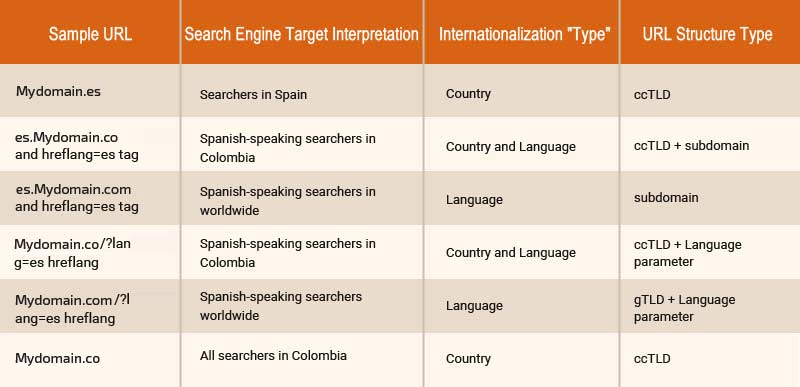Everything done for a local business can be scaled to make way for a global company, only with tactics and resources on a bigger, wide-spread and international level. The International SEO process optimizes a business website in such a manner that search engines would easily identify the targeted country, specific language, and content for visitors in different geographical areas. There are many things involved, and an enormous number of activities must be performed to achieve business goals.




 It is imperative to understand that search engines interpret different URLs in different ways and choosing the right structure will be crucial to the success of your international website.
The table below shows a few combinations of possible domain structures that can be useful to make a website international:
It is imperative to understand that search engines interpret different URLs in different ways and choosing the right structure will be crucial to the success of your international website.
The table below shows a few combinations of possible domain structures that can be useful to make a website international:

A little bit of International SEO History
The illustrative timeline of International SEO history shown in the pictures below is derived from Google Webmaster blog announcements. You will see something about Bing and Yandex, but it is created only on Google. The history here is not at all an all-inclusive timeline.Do you need to go International?
You may already be aware that a significant chunk of traffic to your website comes from different countries. Those visitors coming to your site speak different languages. This means that you should complement your website with necessary changes to give a better experience for all the visitors landing on your site from the many countries. As it may sound, International Search Engine Optimization is not foreign in concept. In the process of International SEO, you are optimizing your website for different countries and languages instead of optimizing your website solely to attract traffic from near your location. If you want to create a truly international website that targets specific countries and language, you need to incorporate an international-friendly URL that specifies the targeted country. You also need to focus on language targeting by creating your web pages in the targeted language. These are the raw materials with which you’ll rank. Does it mean that you need a site for each separate country? Well, to be frank, the answer is yes if your targeted user market is big enough for you to invest. It will help you not just from SEO perspective but by providing a better user experience to each local audience. It is always beneficial to have a dedicated website for targeted countries. If you are at the initial stage of your business, this may not be a feasible option for you.What kind of hosting you will need?
When it comes to International SEO related geo-targeting, the location of the website host server is one of the most important signals. However, it is not critical as there are other ways to indicate your website’s target market to search engines correctly. Remember that the host location has a significant effect on the page speed, and your site needs to be accessed in the target countries as quickly as possible and without lag.What is the best domain strategy?
For each targeted country, webmasters can get country-specific domains for the website. It will have a country code top-level domain (ccTLD), a subdomain, a subdirectory or sub folder, a gTLD with language parameters, or even using a different domain name entirely.ccTLD
The 2-letter code indicates the origin and demographic identity of the website for users as well as search engines.

Subdomain
Content created for international users is placed on a separate “third-level domain” that may or may not pass or receive link equity from the root domain.

Subdirectory
Content created for an international website is placed in a specific subdirectory, or subfolder, of a root domain.

gTLD with language parameters
A generic top-level domain such as .com, .net, or .org is targeted to audiences speaking a specific language of a different country by appending a URL parameter.

Different domain
Content created for an international website is placed on an entirely different root domain than the non-internationalized site.


How to find the perfect domain strategy for International SEO
Let’s introspect all the different options and their benefits and drawbacks to find the best domain strategy for your needs.(ccTLDs) Country code top-level domains
(ccTLDs) Country code top-level domains are country specific, such as .au for Australia or .co for Colombia. Advantages of ccTLDs- It can be associated with the country they target.
- Easy for visitors to understand that the site is meant for them.
- Will show up in the search results that the site is targeted to a specific country.
- Customers in different countries often prefer visiting a local website.
- In some markets, local ccTLDs perform better in the rankings.
- The cost of owning domains will be high. (If you provide services in 32 countries, you will need 32 ccTLDs.)
- You may have to start from scratch without any domain history when you enter a new market.
- It is not easy to set up language specific websites. A German-language website on a .de domain will look like a German-focused website, not one which can also serve customers in German-speaking Switzerland or Austria.
- The website you have will be filled with numerous external links if you have a country or language selection drop-down on all pages.
- If you choose to do SEO work on your main site, it will not benefit all the other sites as they are all separate websites.
Subfolders or subdirectories
Subfolders or subdirectories created for specific languages or countries can be added to any domain (www.mydomain.com/us). However, your website needs to be on a top-level domain.com not on a local ccTLD. Advantages of subfolders- SEO work done on the domain will help all the country folders.
- You will also have the added legacy of the history of your original website, which means you arenot starting from scratch when you enter a new market.
- Links between countries are internal links, not external ones, which helps your backlink profile.
- There will be no extra domain hosting costs.
- In the search results, it will not show the country subfolder is specifically for users in that country.
- There will be no automatic association in a search to the targeted country.
- At times, different international landing pages end up competing in search engine results. This can make it difficult to get the right landing page to rank in the relevant country’s search.
Subdomains
When you want to add the country at the beginning of the domain, subdomains do the job. There are CMS tools and proxies default to this behavior. However, this will only work if the main website is on a .com domain. Advantages of subdomains- A default setting for some CMS tools.
- Helps based on the current SEO authority of the main website, which can be beneficial when entering a new market in a different country.
- The links from the language drop-down are seen as external links.
- There is no association in the search engines with the targeted country
- Users are less likely to associate your domain with their country, as the language specification is at the beginning of the domain
- Search engines, like Google, will typically feature just one subdomain from the same site. It means that your subdomains will end up competing with one another for the same search terms.
Language-target your website (or website pages)
Here is an example that would instruct Google that an alternate version of the content is available in French at the link provided. Example hreflang tag:< link rel="alternate" href="http://example.com/fr" hreflang="fr-fr"/ >
Tailor your content to your target user’s language and culture
An International website must be different from a home country website, targeting different languages, places,and demands of the people. To get the expected digital marketing results, the site should be optimized according to the need of each country’s local audience. For example, high-level content on your website in the UK market may not do as well in South America or other countries and may require additional content edits. Keeping in mind the overall performance of different websites, make sure that they do not compete; otherwise, they might not be indexed by the search engines. For example, a website optimized for England should not appear in the search results of Germany.Other SEO signals
There are other ways which can tell search engines that your website is targeting a specific country, such as –- Hosting your site on a local IP
- Linking to local content
- Building links from local resources
- Finding ways to rank on local search engines like Yandex in Russia and Baidu in China
The benefits of International SEO
- You can take your business to a global audience.
- You will be able to select the relevant keywords for specific countries while optimizing content and SEM campaigns.
- Going international means increased website traffic thereby improving conversion rates.
- The enhanced user experience that will help to establish your business as a global brand and have more customers returning to your website.
The International SEO Checklist:
- SEO-friendly website structure
- Find your current international audience
- Do your SERP research
- Manage multilingual versions of your site
- Determine Language vs. Country Targeting
- Let the users switch webpage language
- Short descriptive URL structure
- Keep an eye on website speed
- Make sure the website is mobile-friendly
- Localize your content
- Video optimization
- Clean Titles and Meta tags
- HrefLang tags to avoid duplicate content issues on the various English language versions of your website used to target various locations
- Use of proper H1, H2, H3, H4… tags in webpage content structure
- Image alt tags optimization
- Internal linking with SEO friendly anchor text
- Optimize XML sitemap and submit to Google
- Robots.txt optimization
- Regular brand promotion on different social media channels
- Identify bad redirects and fix them
- Fix broken links, errors, and crawl issues
- Get links from country-specific websites
- City, regional, and country-specific citations
- Quality international link building
Summary
Name
Everything You Need to Know About International SEO
Author
Kevin, Vice President - Digital Marketing
Published on
September 14, 2018
Kickstart Your Project With Us!
Popular Posts
CONTACT US
Let's Build Your Agile Team.
Experience Netsmartz for 40 hours - No Cost, No Obligation.
Connect With Us Today!
Please fill out the form or send us an email to








